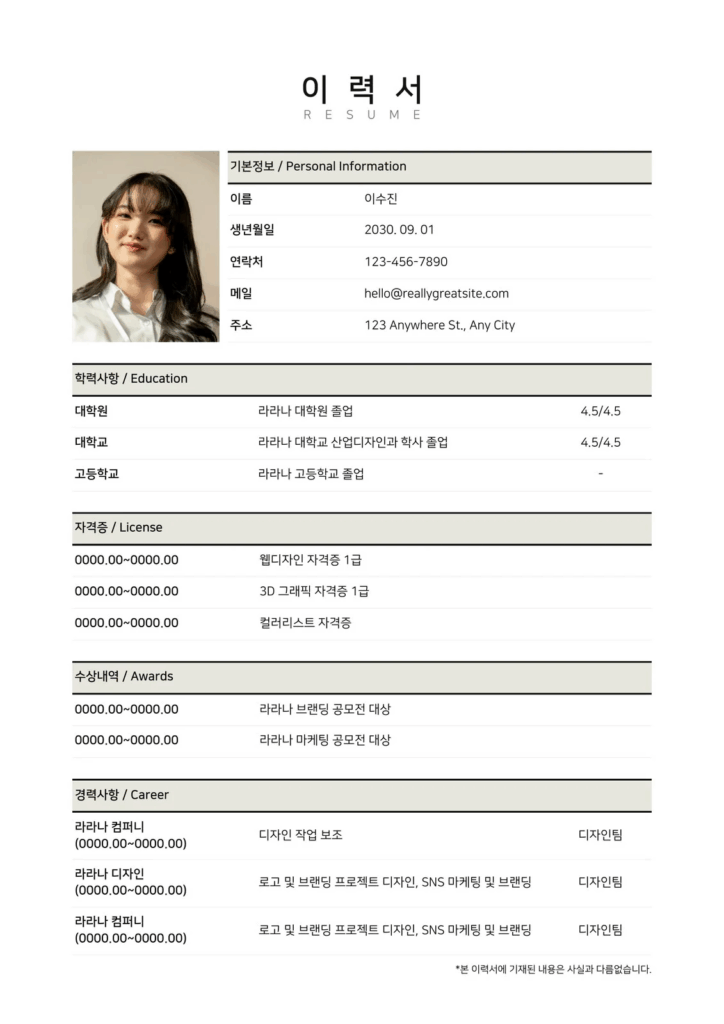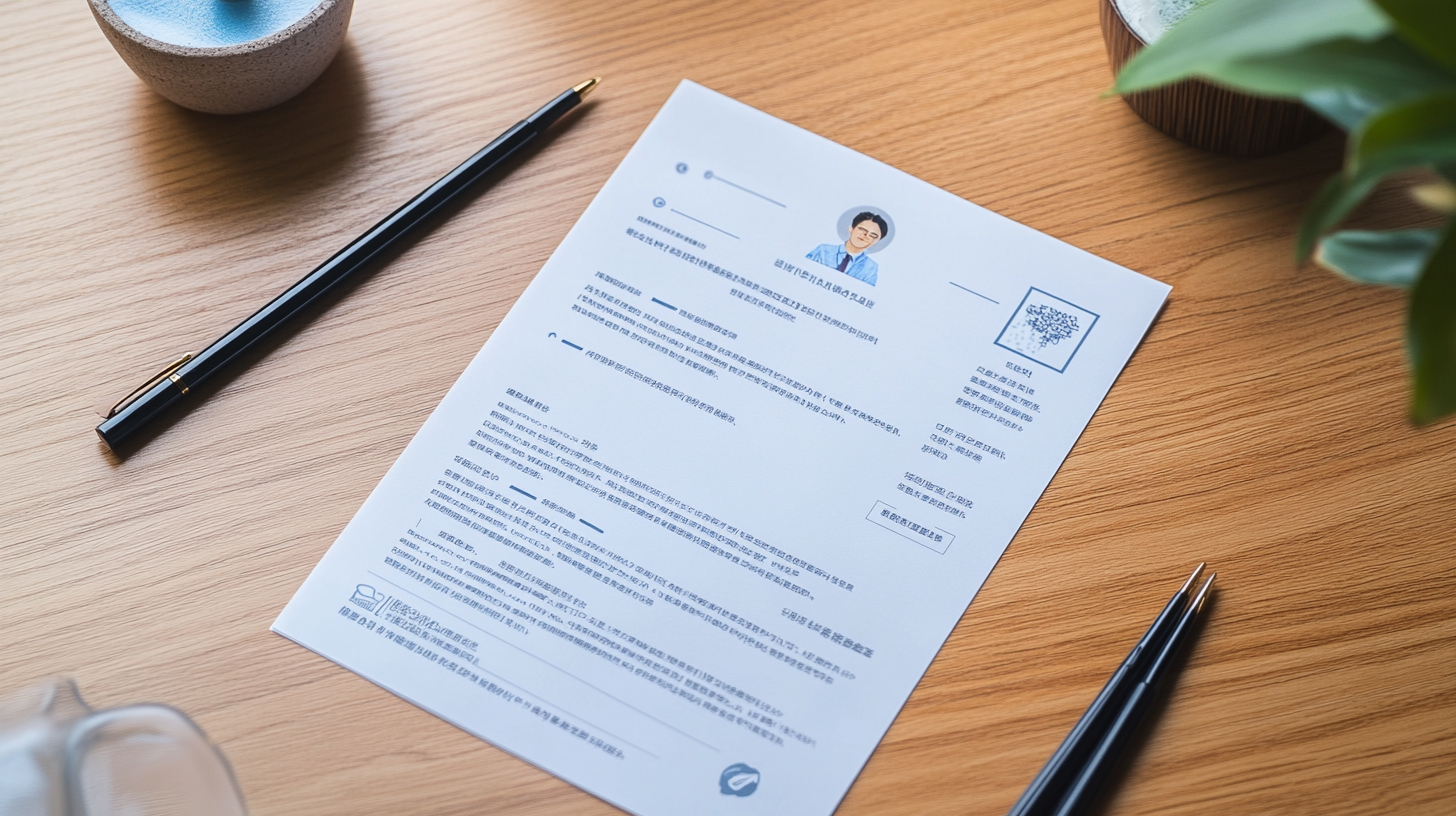In Korea, it is well known that submitting a resume and cover letter is the essential first step to getting a job. However, for foreigners, the Korean-style resume format can be unfamiliar, and the approach to writing a self-introduction (cover letter) may differ significantly from that of their home country. Korean companies typically expect applicants to organize their photo, education, work experience, and self-introduction in a structured, Korean-language layout. Failure to meet these formatting expectations can often lead to being screened out in the initial document review.
In this article, we’ll provide useful tips on how to prepare a Korean-style resume and cover letter specifically for foreigners. From attaching a photo to choosing the right writing tone, we’ll walk you through every essential detail.
1) Basic Structure of a Korean-Style Resume
Photo: Is it Really Necessary?
Most Korean resumes require a formal ID photo. While Western countries avoid photos due to discrimination concerns, in Korea, including a photo has traditionally been the norm. Some large conglomerates have recently moved away from this, but many SMEs and conventional companies still expect it.
If you’re a foreigner, this might feel awkward. However, since many companies still expect this format, it’s generally advisable to attach a passport-style photo (3.5×4.5cm) in neat business attire. If you’re uncomfortable with this, consider applying to companies that don’t require photos, such as global businesses.
Personal Details: Name, Contact Info, Date of Birth
In Korean resumes, personal information is often listed at the top. Foreign applicants should provide their name (in English or with Korean phonetic spelling), email, phone number, and current residence. Including a Korean name pronunciation can help HR recognize your name more easily. While some templates ask for date of birth or gender, these details are increasingly being omitted for privacy reasons. Include only what is required and avoid excessive personal data.
Education, Work Experience, Certifications
The education section usually starts from the university level. Pre-college education is often omitted. Korean companies place high importance on your degree and major. Clearly indicate your attendance period and degree, for example: “2015.09~2019.06, Bachelor of Computer Science, University of XXX”.
List your work experience in reverse chronological order, clearly stating company name, role, employment period, and responsibilities. When possible, include both the English and Korean name of the company. Briefly highlight achievements such as projects and contributions to revenue. Create a separate section for certifications (e.g., TOEIC, TOPIK) and language proficiency.
Additional Information: Military Service, Awards, Hobbies/Special Skills
Some Korean resumes have a section for military service. If you’re not subject to this, you can leave it blank or write “Not applicable” if it’s a required field. You can also include awards, volunteer work, and projects—make sure to translate and explain any foreign experience appropriately.
Hobbies and special skills are common in Korean resumes but may feel unfamiliar to foreigners. Aim for a balance—don’t be too casual or overly dramatic. Including sincere hobbies like “jogging, photography, learning Korean cooking” can give a positive impression.

2) How to Structure a Korean-Style Self-Introduction (Cover Letter)
Why Do You Need a Cover Letter?
Korean companies use cover letters to assess a candidate’s personality, values, and cultural fit with the company. While a resume shows your academic and professional background, the cover letter is a narrative of your personal growth. For foreign applicants, recruiters are especially curious about motivations like “Why do you want to work in Korea?” or “How did you learn Korean and adjust to its culture?”
Typical Paragraph Structure
- Growth Background: A short summary of your background—family, education, personality, and challenge-driven mindset.
- Strengths and Weaknesses: Emphasize teamwork and communication skills.
- Motivation and Job Fit: This is the key part. Clearly explain how your experience and skills will contribute to the company.
- Aspirations and Vision: Share your future goals and express your willingness to grow together with the company.
Tone and Length
If you’re fluent in Korean, avoid using honorifics and instead write in a natural, first-person narrative style typical of Korean cover letters. Phrases like:
“I learned [something] through [an experience]. I believe this will be helpful for [specific job functions].”
The length should match the company’s specifications (e.g., 3,000 characters). Too short may seem careless, while overly long may be tiring to read.
Unique Strengths for Foreign Applicants
- Language & Cultural Advantage: “As a native English (or Spanish, Chinese, etc.) speaker, I am strong in international sales.”
- Global Perspective: “My deep understanding of foreign markets and cultures can help in both the Korean and global market expansion.”
- Connection to Korea: “I studied Korean hard and passed TOPIK Level 5. As a fan of K-POP, I have a deep appreciation of Korean pop culture.”
- Adaptability: “Having studied/lived abroad, I am quick to adapt to new environments and challenges.”
3) Details: Photos, Formats, Fonts, and More
Photo Background & Attire
Choose a clear white or pastel background for your application photo. Standard attire includes formal tops such as blouses, shirts, or jackets. Hair should be neat, and flashy accessories avoided. A clean, passport-style photo is sufficient—even for foreigners.
File Format: HWP vs. MS Word (.docx) vs. PDF
Korean companies often prefer HWP (Hangul Word Processor) files. As a foreigner, you may not be used to this format, so consider installing the software or using a converter. Some companies accept Word or PDF, but always follow the application instructions carefully.
Fonts & Layout
Stick to standard fonts in black (10–11 pt), like “Malgun Gothic” or “Gulim”. Avoid background colors or elaborate decorations. Maintain readability throughout your documents. Use translation and proofreading tools to minimize awkward phrasing, or consider having a native Korean friend or professional proofreader review your application for natural flow.
4) Preparing for the Interview: Keep Your Story Consistent
Interviews Verify Resume Content
Korean interviewers often ask questions directly tied to your submitted documents. For example, “You mentioned a project in your cover letter—could you elaborate?” Any misinformation or exaggeration in your resume could lead to serious consequences during the interview, so ensure your story is consistent and work hard to prepare your explanations.
Korean vs. English Interviews
Some companies may hold the interview in English considering your background, but others may still ask Korean questions to gauge basic communication skills. If you claim to have TOPIK Level 4, they may test your speaking ability. Practicing common questions such as self-introduction, work history, and reasons for applying—in Korean—can help you leave a strong impression.
5) Final Checklist: Common Mistakes and How to Fix Them
Mistake 1: Date Inconsistencies in Work or Education
Inconsistent timelines or missing dates confuse HR managers. Double-check your resume and clearly differentiate between part-time, internship, and full-time positions.
Mistake 2: Plagiarized or Machine-Translated Cover Letters
Copy-pasting cover letter examples or submitting poorly translated documents creates a bad impression. Every company has different questions. Craft your own story tailored to each role. Never submit machine translations without proper review.
Mistake 3: Inappropriate Photos (Casual Clothes, Party Backgrounds)
Attaching selfies from nightclubs or travel photos can be seen as unprofessional. Make sure your photo resembles a simple ID picture taken in formal attire.
Conclusion: Korean-Style Applications Are Challenging, But Worth the Effort
While some roles in Korea may only require English, many companies still expect resumes and cover letters in traditional Korean formats. Even if customizing your documents—adding a photo, tailoring your work history, writing a detailed cover letter—feels tiresome, skipping these steps can easily lead to rejection.
Companies value consistent formatting and use the cover letter to evaluate a candidate’s personality, passion, and cultural fit. However, if you get the right translation and proofreading support and present your personal story sincerely, you have an excellent opportunity to showcase your strengths as a foreign applicant.
Explain clearly: “I had this unique experience abroad” or “This is why I love Korea and can contribute to your company.” HR managers will take notice. Lastly, make sure your interview responses align with your written documents—it’s key to leaving a great impression.
If you’ve read through this guide and now understand how to create a Korean-style resume and cover letter, we encourage you to try drafting your documents and seek Korean language review or feedback from a friend. These small details will significantly increase your chances of passing the document screening stage at Korean companies.

WeBring Service : Provides personalized services to foreigners living in Korea
Exclusive offer: Introducing foreign car rental in Korea, WeBring-SoCar

